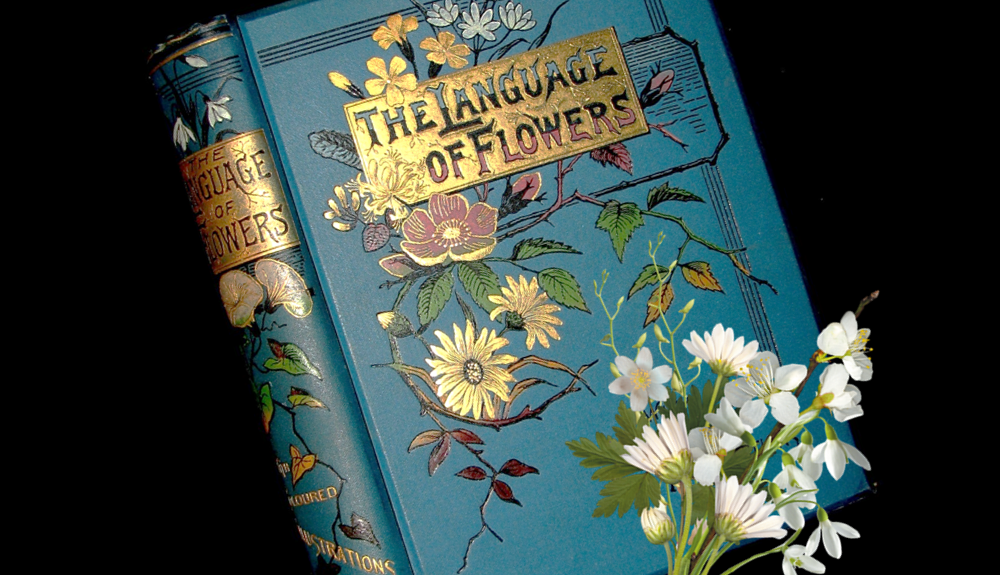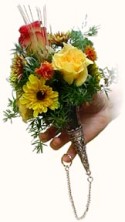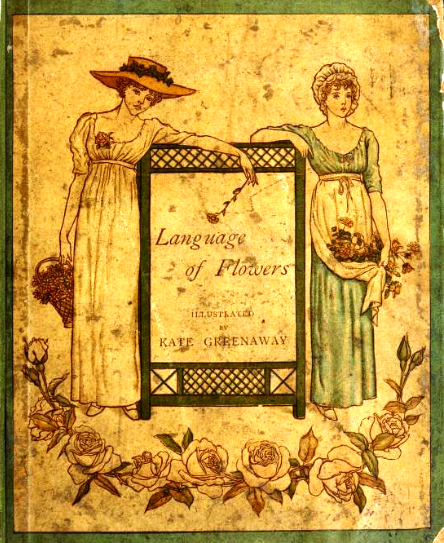
“The Language of the Flowers” by Robert Tyas, 1880
During the Victorian era, people often gave each other flowers and used the “language of flowers” (sometimes called floriography) to express feelings that, because of the propriety of the times, could not be spoken. The flowers said it all. Each flower, herb, and vine had a special meaning, and it was important to carefully choose those that best conveyed just the right sentiments.
 Small bouquets of tightly gathered flowers and plants, called Tussie Mussies, were common. These “talking bouquets,” designed to carry specific personal messages, were often given by gentlemen suitors of the era to the young women they were courting.
Small bouquets of tightly gathered flowers and plants, called Tussie Mussies, were common. These “talking bouquets,” designed to carry specific personal messages, were often given by gentlemen suitors of the era to the young women they were courting.
Books on the language of flowers, listing flowers in alphabetical order alongside their illustrations and meanings, were popular and helped young women (or any woman, for that matter) identify the hidden messages to be found in floral gifts. By the end of the Victorian era, greetings cards were also widely available, depicting an appropriate flower for each occasion.
Today, though we still “say it with flowers,” we no longer personally select flowers based on their meanings. Instead, we choose flowers by color or preference and rely on the expertise of professional florists to create a perfect bouquet or floral arrangement.
A

“The Language of Flowers” by Kate Greenaway, 1884
View the Book
Anemone (garden) – Forsaken
Apple Blossom – Preference,
fame speaks him great and good
Aster – Variety, afterthought, daintiness
Azalea – Temperance
B
Bachelor’s Button – Celibacy, single blessedness
Begonia – Beware
Black-eyed Susa – Justice
Bluebell – Constancy, humility
Buttercup – Ingratitude, childishness
C
Calla Lily – Beauty
Camellia (pink) – Longing for you
Camellia (red) – Unpretending excellence, you’re a flame in my heart
Camellia (white) – Perfected loveliness, you’re adorable
Carnation (deep red) – My heart aches for you, pure love, deep love
Carnation (pink) – Woman’s love, longing for you, I’ll never forget you
Carnation (purple) – Capricious, whimsical, changeable
Carnation (striped) – Refusal
Carnation (white) – Sweet and lovely, pure love, innocence, endearment
Carnation (yellow) – Disappointment, rejection, disdain
Cherry Blossom – Kind and gentle, spirituality, beauty
Chrysanthemum (red) – I love you
Chrysanthemum (yellow) – Slighted love
Chrysanthemum (white) – Truth
Clematis – Mental beauty
Cornflower – Celibacy
Crocus (spring) – Cheerfulness, youthful gladness
D – E – F
Dahlia – Instability, good taste
Daisy – Innocence, loyal love, I’ll never tell
Dandelion – Rustic oracle
Daylily – Chinese symbol for mother
Fern – Magic, fascination, secret bonds of love
Forget-Me-Not – True love memories, do not forget me
Forsythia – Anticipation
Foxglove – Insincerity
Fuschia (scarlet) – Taste
G – H
Geranium – Folly, stupidity
Gladiolus – I am sincere, integrity, strength, victory
Goldenrod – Precaution, encouragement, good fortune
Heather(lavender) – Admiration, solitude
Heather(white) – Protection, wishes will come true
Hibiscus – Rare beauty, delicate beauty, gentle disposition
Holly – Defense, domestic happiness
Honeysuckle – Generous and devoted affection, bonds of love
Hyacinth – Sport, game, play
Hyacinth (blue) – Constancy
Hyacinth (purple) – I am sorry, please forgive me, sorrow
Hyacinth (pink or red) – Play
Hyacinth (white) – Unobtrusive loveliness, prayers for someone
Hyacinth (yellow) – Jealousy
Hydrangea – A boaster, heartlessness, frigidity, gratitude for being understood
I – J
Ivy – Fidelity, marriage, affection, friendship
Jasmine – Amiability, you are cheerful and graceful
L
Larkspur (pink) – Fickleness
Larkspur (purple) – Haughtiness
Lavender – Devotion, distrust
Lilac (purple) – First emotions of love
Lilac (white) – Youthful innocence
Lily (day) – Coquetry
Lily (imperial) – Majesty
Lily (white) – Purity, sweetness
Lily (yellow) – Happy, walking on air, gaiety
Lily of the Valley – Return to happiness, sweetness, humility/ tears of the virgin Mary
Lotus Flower – Purity, enlightenment, self-regeneration, rebirth
M
Marigold – Pain and grief, jealousy
Mistletoe – I surmount difficulties
Morning Glory – Affectation
Myrtle – Love in marriage, good luck
N – O – P – Q
Orange Blossom – Your purity equals your loveliness
Orchid – A belle, beauty, luxury, refinement
Pansy – Pleasant thoughts
Peony – Shame, bashfulness, happy life
Periwinkle (blue) – Early friendship
Periwinkle (white) – Pleasures of memory
Petunia – Resentment, anger, your presence soothes me
Poinsettia – Be of good cheer
Poppy – Consolation
Primrose – Early youth
R
Rose (bridal) – Happy love
Rose (burgundy) – Unconscious beauty
Rose (cabbage) – Ambassador of love
Rose (Christmas) – Tranquillize my anxiety
Rose (coral or orange) – Desire, passion
Rose (deep red) – Bashful shame
Rose (lavender or violet) – Love at first sight
Rose (light pink) – Joy of life, youth, energy, desire, passion
Rose (dark pink) – Gratitude
Rose (pink) – Perfect happiness, grace, trust, confidence
Rose (red-and-white) – Unity
Rose (single) – Simplicity
Rose (thornless) – Love at first sight
Rose (white) – I am worthy of you
Rose (yellow) – Dying love, platonic love, jealousy, infidelity
Rosebuds – Beauty and youth, pure and lovely, girlhood
S
Snapdragon – Presumption, deception, graciousness
Sunflower – Haughtiness, pure and lofty thoughts, adoration
Sweet Pea – Good-bye, departure, delicate pleasures, thank you for a lovely time
T – U – V – W – X – Y – Z
Tulip (red) – Declaration of love
Tulip (variegated) – Beautiful eyes
Tulip (violet or blue) – Faithfulness
Tulip (white) – Modesty
Tulip (yellow) – Hopeless love, one-sided love, sunshine in your smile
Verbena – Cooperative
Violet (blue) – Faithfulness, I’ll always be true
Violet (white) – Modesty, innocence, let’s take a chance
Violet (yellow) – Rural happiness
Zinnia (mixed bouquet) – Thinking (or in memory) of an absent friend
Top photo: THE LANGUAGE OF FLOWERS by Robert Tyas. London and New York: Frederick Warne and Co., c.1880.